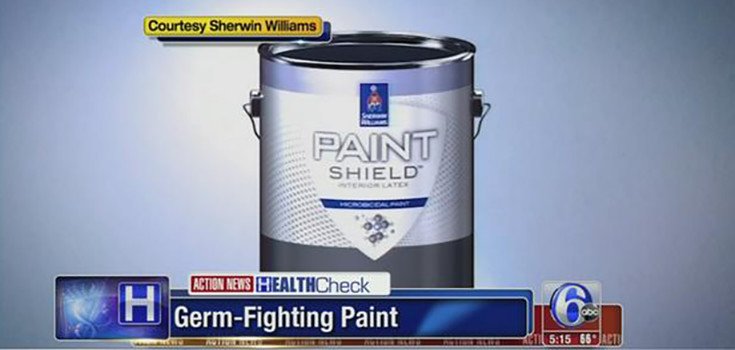New Paint Kills Bacteria, but it Could be Hazardous to Human Health

A new paint manufactured by Sherwin-Williams may help stop the spread of “superbugs” in hospitals and other places that are notorious for the spread of drug-resistant bacteria.
Sherwin-Williams announced last week that it has developed Paint Shield, a new paint that kills tough bacteria. Paint Shield successfully passed third-party tests for safety and certification and health claims confirmation with the U.S. Environmental Protection Agency (EPA) for killing more than 99.9% of bacteria including Staph, E. coli, and MRSA, according to Steve Revnew, senior vice president of product innovation for Sherwin-Williams. Revnew says the paint could be used to coat the walls of medical complexes, locker rooms, schools, daycare centers, hotels, homes and cruise ships. [1]
EPA test protocols show that Paint Shield’s antibacterial capability can last up to 4 years as long as the surface integrity is preserved. The paint was developed by more than 350 chemists, coating scientists and microbiologists at the company’s Breen Technology Center in Cleveland. [2]
“Paint Shield is one of the most significant technological breakthroughs in our nearly 150-year history of innovation,” said Chris Connor, Sherwin-Williams’ chairman and chief executive, in a written statement. “By killing infectious pathogens on painted surfaces, Paint Shield is a game-changing advancement in coatings technology.”
According to the U.S. Department of Health and Human Services (DHHS), healthcare-related infections are one of the main causes of preventable deaths in America. The U.S. Centers for Disease Control and Prevention (CDC) says that 1 in 25 U.S. patients contracts at least one infection while in the hospital. [3]
Sherwin-Williams boasts that Paint Shield is unique because it doesn’t just prevent the growth of common bugs, it also kills infectious microbes, thanks to the product’s active ingredient, Alkyl Dimethyl Benzyl Ammonium Chloride, or “quat.” [4]
Revnew says that Paint Shield “was designed to meet the most stringent VOC (volatile organic compounds) regulations” in the U.S. and doesn’t require any special tools to apply. The paint goes on hard, non-porous interior surfaces, including ceilings, walls, doors and trim like regular paint.
“Continued progress in combating HAIs [hospital-acquired infections] will require a broad array of measures, including passive methods that are less dependent on human intervention,” Revnew said. “By continuing to kill MRSA and other bacteria, even after repeated contamination, Paint Shield offers hospitals and other facilities an important new tool to help in the fight against the spread of HAIs (hospital-acquired infections).”
Quat is nothing new, but this is the first time that scientists have been able to suspend them in paint.
“Paint Shield is one of the most significant technological breakthroughs in our nearly 150 year history of innovation,” said CEO Chris Connor.
But is the Alkyl Dimethyl Benzyl Ammonium Chloride found in Paint Shield as safe as the EPA claims?
Quat has been found to cause birth defects and infertility in mice, a 2008 article in the journal Nature states. It had been found in the disinfectant Virex used in the Case Western Reserve Medical School in Cleveland, Ohio, where the mice were housed.
When asked whether the chemicals might be hazardous to human health, researcher Patricia Hunt at Washington State University in Pullman told Nature:
“What concerns me is that they persist for so long in the environment. Given our experience, I am concerned that they might have a deleterious effect on the ovary, uterus and in lactation. This group of compounds acts on the cell membrane, and does a fantastic job of killing everything. But, you know, we’re composed of membranes too.
I think the effects we’ve seen are very significant and potentially important for human health and reproduction, so I’d like to see someone research it.”
Sources:
[1] Tech Times
[2] Cleveland.com
[3] Daily Mail
[4] USA Today

If it can kill bugs, it can kill you. It’s not like they’re mixing colloidal silver in.
That is not true. People are not bugs. We do not have the same physiology. Yes we have cell membranes as the Researcher Patricia Hunt stated, but if it were true that just because it kills bugs it can kill people, then any time we use mosquito repellent on our skin or bug spray in the garden, we’d die. That’s a ridiculous statement usually reserved for psychotic naturalists who claim anything that is not natural is dangerous. Just remember arsenic is completely natural.
that type of paint has been around for decades
Poorly written article as usual. It repeats the same information more than once and kept explaining what HAIs (hospital-acquired infections) were too by spelling it out in parentheses. That should only be done ONCE the first time it is mentioned. Man, it seems ANYONE can claim they’re a writer these days. I have GOT to stop reading on the Internet.